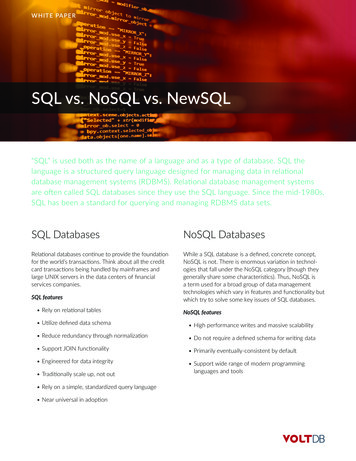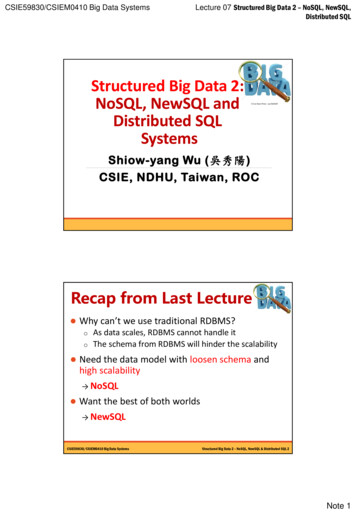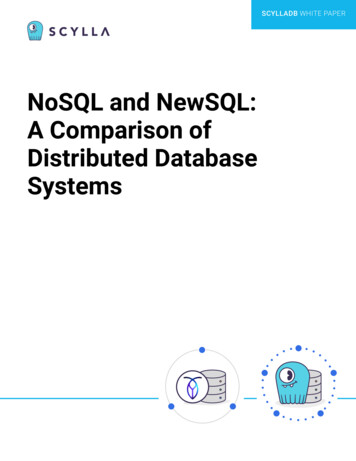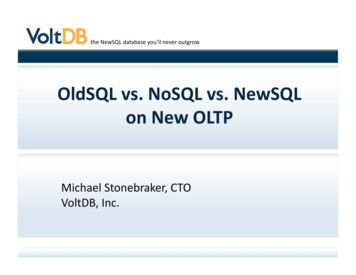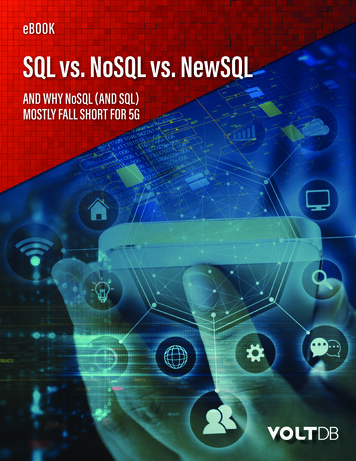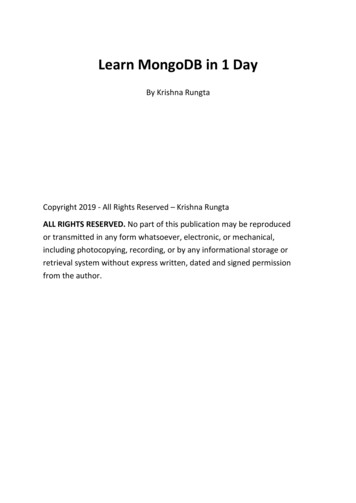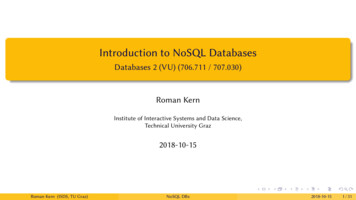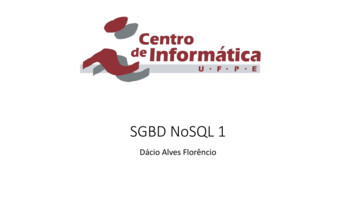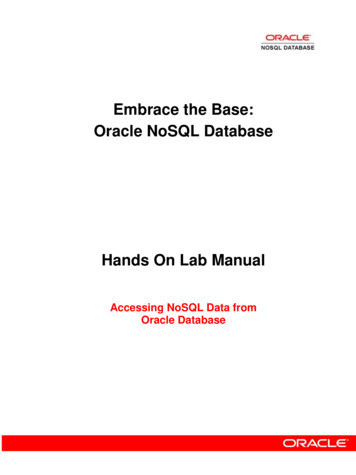
Transcription
NoSQL & NewSQLInstructor:Peter y.de-3178room 88, Research 1With material by Willem VisserDatabases & Web Applications (P. Baumann)
Overview NoSQL Transactions NewSQLDatabases & Web Applications (P. Baumann)2
NoSQLDatabases & Web Applications (P. Baumann)
Performance Comparison On 50 GB data: MySQL Writes 300 ms avg Reads 350 ms avg Cassandra Writes 0.12 ms avg Reads 15 ms avgDatabases & Web Applications (P. Baumann)4
We Don‘t Want No SQL ! NoSQL movement: SQL considered slow only access by id („lookup“) Deliberately abandoning relational world: „too complex“, „not scalable“ No clear definition, wide range of systems Values considered black boxes (documents, images, .) simple operations (ex: key/value storage), horizontal scalability for those ACID CAP, „eventual consistency“ Systemsdocumentscolumnskey/values Open source: MongoDB, CouchDB, Cassandra, HBase, Riak, Redis Proprietary: Amazon, Oracle, Google , Oracle NoSQL See also: 2010/Databases & Web Applications (P. Baumann)5
NoSQL Previous „young radicals“ approaches subsumed under „NoSQL“ we want „no SQL“ Well.„not only SQL“ After all, a QL is quite handy So, QLs coming into play again (and 2-phase commits ACID!) Ex: MongoDB: „tuple“ JSON structuredb.inventory.find({ type: 'food', or: [ { qty: { gt: 100 } }, { price: { lt: 9.95 } } ]} )Databases & Web Applications (P. Baumann)6
Another View: Structural Variety in Big Data Stock trading: 1-D sequences (i.e., arrays) Social networks: large, homogeneous graphs Ontologies: small, heterogeneous graphs Climate modelling: 4D/5D arrays Satellite imagery: 2D/3D arrays ( irregularity) Genome: long string arrays Particle physics: sets of events Bio taxonomies: hierarchies (such as XML) Documents: key/value stores sets of unique identifiers whatever etc.Databases & Web Applications (P. Baumann)7
Another View: Structural Variety in Big Data Stock trading: 1-D sequences (i.e., arrays) Social networks: large, homogeneous graphs Ontologies: small, heterogeneous graphs Climate modelling: 4D/5D arrays Satellite imagery: 2D/3D arrays ( irregularity) Genome: long string arrays Particle physics: sets of events Bio taxonomies: hierarchies (such as XML) Documents: key/value stores sets of unique identifiers whatever etc.Databases & Web Applications (P. Baumann)8
Structural Variety in [Big] Datasets hierarchies graphs arraysDatabases & Web Applications (P. Baumann)9
Ex 1: Key/Value Store Conceptual model: key/value store set of key value Operations: Put(key,value), value Get(key) large, distributed hash table Needed for: twitter.com: tweet id - information about tweet kayak.com: Flight number - information about flight, e.g., availability amazon.com: item number - information about it Ex: Cassandra (Facebook; open source) Myriads of users, like:Databases & Web Applications (P. Baumann)10
Ex 2: Document Stores Like key/value, but value is a complex document Data model: set of nested records Added: Search functionality within document Full-text search: Lucene/Solr, ElasticSearch, . Application: content-oriented applications Facebook, Amazon, Ex: MongoDB, CouchDBdb.inventory.find( { or: [ { status: "A" }, { qty: { lt: 30 } } ] } )SELECT * FROM inventory WHERE status "A" AND qty 30Databases & Web Applications (P. Baumann)11
Ex 3: Hierarchical Data Disclaimer: long before oks.xml")/bookstore/book[price 30] Later more, time permitting!Databases & Web Applications (P. Baumann)12
Ex 4: Graph Store Conceptual model: Labeled, directed, attributed graph Why not relational DB? can model graphs! but “endpoints of an edge” already requires join No support for global ops like transitive hull Main cases: Small, heterogeneous graphs Large, homogeneous graphsDatabases & Web Applications (P. Baumann)13
Ex 4a: RDF & SPARQL Situation: Small, heterogeneous graphs Use cases: ontologies, knowledge graphs,Semantic Web Model: Data model: graphs as triples RDF (Resource Data Framework) Query model: patterns on triples SPARQL (see later, time permitting)Databases & Web Applications (P. Baumann)PREFIX foaf: http://xmlns.com/foaf/0.1/ SELECT ?name ?mboxWHERE{?x foaf:name ?name .?x foaf:mbox ?mbox}14
Ex 4b: Graph Databases Situation: Large, homogeneous graphs Use cases: Social Networks Common queries: My friendswho has no / many followersclosed communitiesnew agglomerations,new themes, . Sample system: Neo4j with QL CypherMATCH (:Person {name: 'Jennifer'})-[:WORKS FOR]- (company:Company)RETURN company.nameDatabases & Web Applications (P. Baumann)15
Ex 5: Array Analytics Array Analytics : Efficient analysis on multi-dimensional arraysof a size several orders of magnitude abovethe evaluation engine‘s main memorysensor, image [timeseries],simulation, statistics data Essential property: n-D Cartesian neighborhood[rasdaman]Databases & Web Applications (P. Baumann)16
Ex 5: Array Databases Ex: rasdaman Array DBMS Data model: n-D arrays as attributes Query model: Tensor Algebraselect img.raster[x0:x1,y0:y1] 130from LandsatArchive as img Demo at http://standards.rasdaman.org Multi-core, distributed, platform for EarthServer (https://earthserve.xyz) Relational? „Array DBMSs can be 200x RDBMS“ [Cudre-Maroux]Databases & Web Applications (P. Baumann)17
TransactionsDatabases & Web Applications (P. Baumann)
No More ACID RDBMS provide ACID locally Close to impossible to achieve in distributed situations Instead: BASE Basically Available Soft-state Eventual Consistency Prefers availability over consistency Ex: CassandraDatabases & Web Applications (P. Baumann)19
Outlook: ACID vs BASE BASE Basically Available Soft-state Eventual Consistency availability over consistency, relaxing ACID ACID model promotes consistency over availability,BASE promotes availability over consistency Comparison: Traditional RDBMSs: Strong consistency over availability under a partition Cassandra: Eventual (weak) consistency, availability, partition-tolerance CAP Theorem [proposed: Eric Brewer; proven: Gilbert & Lynch]:In a distributed system you can satisfy at most 2 out of the 3 guarantees Consistency: all nodes have same data at any time Availability: system allows operations all the time Partition-tolerance: system continues to work in spite of network partitionsDatabases & Web Applications (P. Baumann)20
Discussion: ACID vs BASE Justin Sheely: “eventual consistency in well-designed systems does notlead to inconsistency” Daniel Abadi: “If your database only guarantees eventual consistency, youhave to make sure your application is well-designed to resolve allconsistency conflicts. [ ] Application code has to be smart enough to dealwith any possible kind of conflict, and resolve them correctly” Sometimes simple policies like “last update wins” sufficient other apps far more complicated, can lead to errors and security flaws Ex: ATM heist with 60s window DB with stronger guarantees greatly simplifies application designDatabases & Web Applications (P. Baumann)21
CAP Theorem Proposed by Eric Brewer, UCB; subsequently proved by Gilbert & Lynch In a distributed system you can satisfy at most 2 out of the 3 guarantees Consistency: all nodes have same data at any time Availability: system allows operations all the time Partition-tolerance: system continues to work in spite of network partitions Traditional RDBMSs Strong consistency over availability under a partition Cassandra Eventual (weak) consistency, Availability, Partition-toleranceDatabases & Web Applications (P. Baumann)22
NewSQLDatabases & Web Applications (P. Baumann)
NewSQL: The Empire Strikes Back Michael Stonebraker: „no one size fits all“ NoSQL: sacrificing functionality for performance – no QL, only key access Single round trip fast, complex real-world problems slow Swinging back from NoSQL:declarative QLs considered good (again), but SQL often inadequate Definition 1: NewSQL SQL with enhanced performance architectures Definition 2: NewSQL SQL enhanced with, eg, new data types Some call this NoSQLDatabases & Web Applications (P. Baumann)24
What Makes an RDBMS Slow?Databases & Web Applications (P. Baumann)25
Column-Store Databases Observation: fetching long tuples overhead when few attributes needed Brute-force decomposition: one value (plus key) Ex: Id SNLRH Id S, Id N, Id L, Id R, Id H Column-oriented storage:each binary table separate file With clever architecture, reassembly of tuples pays off[https://docs.microsoft.com] system keys, contiguous, not materialized, compression, MMIO, . Sample systems: MonetDB, Vertica, SAP HANADatabases & Web Applications (P. Baumann)26
Main-Memory Databases RAM faster than disk load data into RAM, process there CPU, GPU, . Largely giving up ACID„s Durability different approaches Sample systems: ArangoDB, HSQLDB, MonetDB, SAP HANA, VoltDB, .Databases & Web Applications (P. Baumann)27
Arrays in SQL 2014 - 2018 rasdaman as blueprintcreate table LandsatScenes(id: integer not null, acquired: date,scene: row( band1: integer, ., band7: integer ) mdarray [ 0:4999,0:4999] )select id, encode(scene.band1-scene.band2)/(scene.nband1 scene.band2)), „image/tiff“ )from LandsatSceneswhere acquired between „1990-06-01“ and „1990-06-30“ andavg( scene.band3-scene.band4)/(scene.band3 scene.band4)) 0Databases & Web Applications (P. Baumann)28
Summary & Outlook Fresh approach to scalable data services: NoSQL, NewSQL Diversity of technology pick best of breed for specific problem Avenue 1: Modular data frameworks to coexist Heterogeneous model coupling barely understood - needs research Avenue 2: concepts assimilated by relational vendors Like fulltext, object-oriented, SPARQL, . cf „Oracle NoSQL“ “SQL-as-a-service” Amazon RDS, Microsoft SQL Azure, Google Cloud SQL More than ever, experts in data management needed ! Both IT engineers and data engineersDatabases & Web Applications (P. Baumann)29
The Explosion of DBMSs[451 group].notentirely correctDatabases & Web Applications (P. Baumann)30
The Big Universe of Databasesnot entirely m, 2013-aug19]Databases & Web Applications (P. Baumann)31
Databases & Web Applications (P. Baumann) 5 We Don't Want No SQL ! NoSQL movement: SQL considered slow only access by id („lookup") Deliberately abandoning relational world: „too complex", „not scalable" No clear definition, wide range of systems Values considered black boxes (documents, images, .) simple operations (ex: key/value storage), horizontal scalability .
